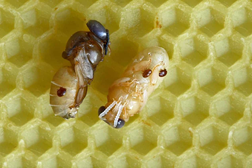Varroa
- Hayden Chrisman-TCA
- Feb 27, 2019
- 2 min read
Updated: Feb 12, 2021
Varroa/Parasitic Mite Syndrome
Varroa is one of the biggest problems in today’s beekeeping industry; proper understanding of them and the ability to identify the symptoms can help us effectively fight them.
Symptoms/Identification
Spotty Brood (can also be from a poor queen)
Deformed wings
Frequent spotting of mites on top of bees and in brood
How it Spreads
Robbing
Foraging
Drifting

Diagnose
Powder Sugar Roll
Alcohol Wash
Kills brood in all stages of development
Treatment
Apivar (A very effective treatment when a hive has 5 or less mites. It is a long-term treatment and will not be effective in hives with high mite counts.)
Oxalic Acid (This treatment is very effective and safe to use. It is most effective during bloodless periods, as it does not kill the mites under the brood. It is very effective for high mite counts as it kills immediately and continues to kill for 4 days. There is room for error in the amount that is applied to the bees. Remember it is better to use little than too much. Apply (for the dribble method) 10mL per seam of bees. During times of brood production this treatment can be used and applied once a week for three weeks. It will usually bring the mite count down to a reasonable number. This treatment can be used to kill high mite counts and then come in with a longer lasting treatment that will kill the bees under the brood.
The vaporizer method requires expensive equipment and is slightly dangerous although it does use less Oxalic Acid.
Parasitic mite syndrome is often confused with (European Foulbrood) and (American Foulbrood).
For both the powder sugar and alcohol roll you need ¼ cup of bees in a jar. For the powder sugar dump several tablespoons into the jar and shake it for several minutes. Insert a mesh lid onto the jar and shake the sugar out. The red mites should show up clearly against the white sugar. My threshold is 3 mites; if there is 4 or mites I treat. The same procedure goes for the alcohol wash except that the mites and bees die.
Mites are transmitted from hive to hive when bees come into contact with each other at water sources, flowers, and collapsing hives.






Comments